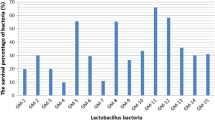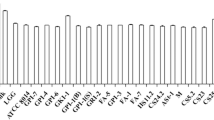Abstract
Purpose
Vitamins and SCFA (short-chain fatty acids) production from Lactobacillus isolates are studied due to its health benefits to the human hosts. Lactobacillus strains are widely used in fermented foods, and few of them are reported with vitamin and SCFA production potential. Therefore, in the present study, vitamins and SCFA production capability of isolates were studied to find the potent Lactobacillus cultures for value-added functional food product development.
Methods
Five Lactobacillus strains, i.e., KGL2, KGL3A, KGL4, RNS4, and WTS4, were isolated from rice-based traditional fermented foods of Garo Hills, Meghalaya, India. All the well grown isolates were morphologically, physiologically, and genetically characterized. Then, vitamins and SCFA were estimated using HPLC based methods. Vitamins produced in vitamins free assay medium and SCFA in milk medium are produced by Lactobacillus.
Results
Lactic acid bacteria produce essential vitamins like riboflavin, folate, cobalamin, and SCFA which have health impacts (anti-obesity, anti-diabetics, anti-microbial, and other chronic diseases prevention) to the host. These vitamins are essential for cellular and metabolic growth of living system. In the study, five potent Lactobacillus isolates viz., KGL2 (Lactobacillus fermentum), KGL3A (Lactobacillus plantarum), KGL4 (Lactobacillus fermentum), RNS4 (Lactobacillus rhamnosus), and WTS4 (Lactobacillus fermentum) were considered for vitamins (B2, B12, and B9) and SCFA productions (lactate, butyrate, and acetate). However, KGL3A had shown highest B2 production (0.7 μg/ml) while KGL2 exhibited maximum B12 production (0.05 μg/ml) after 36 h. Moreover, WTS4 attributed highest folate production (0.09 μg/ml) after 24 h. In addition, RNS4 reported the maximum short-chain fatty acid production (0.77 g/l acetic acid, 0.26 g/l lactic acid, and 0.008 g/l butyric acid respectively).
Conclusions
Potent Lactobacillus isolates from traditional fermented foods of Garo Hills, Meghalaya, India (North East Part of India) showed maximum production of B2, B9, and B12 as well as short-chain fatty acids and could be used for their application as health beneficial functional fermented dairy products.





Similar content being viewed by others
References
Angelis MD, Bottacini F, Fosso B, Kelleher P, Calasso M, Cagno RD, Ventura M, Picardi E, Sinderen DV, Gobbetti M (2014) Lactobacillus rossiae, a vitamin B12 producer, represents a metabolically versatile species within the genus Lactobacillus. PLoS One 9. https://doi.org/10.1371/journal.pone.0107232
Axelsson L (2004) Lactic acid bacteria: classification and physiology. In: Salminen S, Wright AV, Ouwehand A (eds) Lactic acid bacteria: microbiological and functional aspects, 3rd Edition. Marcel Dekker, New York, pp 1–67. https://doi.org/10.1201/9780824752033.ch1
Belenguer A, Duncan SH, Calder AG, Holtrop G, Louis P, Lobley GE, Flint HJ (2006) Two routes of metabolic cross-feeding between Bifidobacterium adolescentis and butyrate-producing anaerobes from the human gut. Appl Environ Microbiol 72:3593–3599. https://doi.org/10.1128/aem.72.5.3593-3599.2006
Besten GD, Eunen KV, Groen AK, Venema K, Reijngoud D-J, Bakker BM (2013) The role of short-chain fatty acids in the interplay between diet, gut microbiota, and host energy metabolism. J Lipid Res 54:2325–2340. https://doi.org/10.1194/jlr.r036012
Bhushan B, Tomar SK, Mandal S (2016) Phenotypic and genotypic screening of human-originated lactobacilli for vitamin B12 production potential: process validation by micro-assay and UFLC. Appl Microbiol Biotechnol 100:6791–6803. https://doi.org/10.1007/s00253-016-7639-9
Bhutia YD, Ganapathy V (2015) Short, but smart: SCFA train T cells in the gut to fight autoimmunity in the brain. Immunity 43:629–631. https://doi.org/10.1016/j.immuni.2015.09.014
Cani PD (2013) The gut microbiota manages host metabolism. Nat Rev Endocrinol 10:74–76. https://doi.org/10.1038/nrendo.2013.240
Chen J, Vitetta L (2018) Inflammation-modulating effect of butyrate in the prevention of colon cancer by dietary fiber. Clin Colorectal Cancer 17. https://doi.org/10.1016/j.clcc.2018.05.001
Chyne DAL, Meshram II, Rajendran A et al (2017) Nutritional status, food insecurity, and biodiversity among the Khasi in Meghalaya, North-East India. Matern Child Nutr. https://doi.org/10.1111/mcn.12557
Gangadharan D, Sivaramakrishnan S, Pandey A, Nampoothiri KM (2010) Folate-producing lactic acid bacteria from cow’s milk with probiotic characteristics. Int J Dairy Technol 63:339–348. https://doi.org/10.1111/j.1471-0307.2010.00590.x
Goh YJ (2009) Genomic features of Lactobacillus species. Front Biosci:1362. https://doi.org/10.2741/3313
Goswami G, Bora SS, Parveen A, Boro RC, Barooah M (2017) Identification and functional properties of dominant lactic acid bacteria isolated from Kahudi, a traditional rapeseed fermented food product of Assam, India. J Ethnic Foods 4:187–197. https://doi.org/10.1016/j.jef.2017.08.008
Gu Q, Zhang C, Song D, Li P, Zhu X (2015) Enhancing vitamin B12 content in soy-yogurt by Lactobacillus reuteri. Int J Food Microbiol 206:56–59. https://doi.org/10.1016/j.ijfoodmicro.2015.04.033
Guru V, Viswanathan K (2013) Riboflavin production in milk whey using probiotic bacteria–Lactobacillus acidophilus and Lactococcus lactis. Indian J Fundam Appl Life Sci 3:169–176
Hill MJ (1997) Intestinal flora and endogenous vitamin synthesis. Eur J Cancer Prev 6. https://doi.org/10.1097/00008469-199703001-00009
Kaprasob R, Kerdchoechuen O, Laohakunjit N, Somboonpanyakul P (2018) B vitamins and prebiotic fructooligosaccharides of cashew apple fermented with probiotic strains Lactobacillus spp., Leuconostoc mesenteroides and Bifidobacterium longum. Process Biochem 70:9–19. https://doi.org/10.1016/j.procbio.2018.04.009
Kimura I, Inoue D, Hirano K, Tsujimoto G (2014) The SCFA receptor GPR43 and energy metabolism. Front Endocrinol 5(85). https://doi.org/10.3389/fendo.2014.00085
Kumar RS, Kanmani P, Yuvaraj N, Paari KA, Pattukumar V, Arul V (2012) Traditional Indian fermented foods: a rich source of lactic acid bacteria. Int J Food Sci Nutr 64:415–428. https://doi.org/10.3109/09637486.2012.746288
Leblanc J, Laiño J, Valle MJD, Vannini V, Sinderen DV, Taranto M, Sesma F (2011) B-group vitamin production by lactic acid bacteria - current knowledge and potential applications. J Appl Microbiol 111:1297–1309. https://doi.org/10.1111/j.1365-2672.2011.05157.x
Leblanc JG, Chain F, Martín R, Bermúdez-Humarán LG, Courau S, Langella P (2017) Beneficial effects on host energy metabolism of short-chain fatty acids and vitamins produced by commensal and probiotic bacteria. Microb Cell Factories 16. https://doi.org/10.1186/s12934-017-0691-z
Macfarlane S, Macfarlane GT (2003) Regulation of short-chain fatty acid production. Proc Nutr Soc 62:67–72
Masuda M, Ide M, Utsumi H, Niiro T, Shimamura Y, Murata M (2012) Production potency of folate, vitamin B12, and thiamine by lactic acid bacteria isolated from Japanese pickles. Biosci Biotechnol Biochem 76:2061–2067. https://doi.org/10.1271/bbb.120414
Mieszkin S, Hymery N, Debaets S, Coton E, Blay GL, Valence F, Mounier J (2017) Action mechanisms involved in the bioprotective effect of Lactobacillus harbinensis K.V9.3.1.Np against Yarrowia lipolytica in fermented milk. Int J Food Microbiol 248:47–55. https://doi.org/10.1016/j.ijfoodmicro.2017.02.013
Miquel S, Martín R, Rossi O, Bermúdez-Humarán L, Chatel J, Sokol, Langella P (2013) Faecalibacterium prausnitzii and human intestinal health. Curr Opin Microbiol 16:255–261. https://doi.org/10.1016/j.mib.2013.06.003
Molina V, Médici M, Valdez GFD, Taranto MP (2012) Soybean-based functional food with vitamin B12-producing lactic acid bacteria. J Funct Foods 4:831–836. https://doi.org/10.1016/j.jff.2012.05.011
Murugan B (2018) Antibacterial activity of indigenous fermented rice beverage of West Garo Hills, Meghalaya, India. Int J Fermented Foods 7. https://doi.org/10.30954/2321-712x.01.2018.5
Oude Elferink SJWH, Krooneman J, Gottschal JC, Spoelstra SF, Faber F, Driehuis F (2001) Anaerobic conversion of lactic acid to acetic acid and 1,2-propanediol by Lactobacillus buchneri. Appl Environ Microbiol 67:125–132. https://doi.org/10.1128/aem.67.1.125-132.2001
Panda SH, Das S, Bal P, Panda SK, Mohanty N (2018) Characterization of novel folate producing Lactobacillus rhamnosus and its appliance in fortification of ragi (Eleusine coracana) gruel. Food Biosci 21:100–106
Papagianni M (2012) Metabolic engineering of lactic acid bacteria for the production of industrially important compounds. Computat Structl Biotechnol J 3. https://doi.org/10.5936/csbj.201210003
Patel A, Shah N, Prajapati JB (2013) Biosynthesis of vitamins and enzymes in fermented foods by lactic acid bacteria and related genera - a promising approach. Croat J Food Sci Technol 5:85–91
Patel M, Patel H (2015) Isolation and molecular characterization of potential plant growth promoting Bacillus megaterium from capsicum cultivation field. J Ind Pollut Control 31:94–104
Pessione E (2012) Lactic acid bacteria contribution to gut microbiota complexity: lights and shadows. Front Cell Infect Microbiol 2(86). https://doi.org/10.3389/fcimb.2012.00086
Roediger WE, Millard S (1995) Selective inhibition of fatty acid oxidation in colonocytes by ibuprofen: a cause of colitis? Gut 36:55–59. https://doi.org/10.1136/gut.36.1.55
Rossi M, Amaretti A, Raimondi S (2011) Folate production by probiotic bacteria. Nutrients 3:118–134. https://doi.org/10.3390/nu3010118
Russo P, Capozzi V, Arena MP, Spadaccino G, Dueñas MT, López P et al (2014) Riboflavin-overproducing strains of Lactobacillus fermentum for riboflavin-enriched bread. Appl Microbiol Biotechnol 98:3691–3700. https://doi.org/10.1007/s00253-013-5484-7
Salazar N, Binetti A, Gueimonde M, Alonso A, Garrido P, Rey CGD et al (2011) Safety and intestinal microbiota modulation by the exopolysaccharide-producing strains Bifidobacterium animalis IPLA R1 and Bifidobacterium longum IPLA E44 orally administered to Wistar rats. Int J Food Microbiol 144:342–351. https://doi.org/10.1016/j.ijfoodmicro.2010.10.016
Santos F, Wegkamp A, Vos WMD et al (2008) High-level folate production in fermented foods by the B12 producer Lactobacillus reuteri JCM1112. Appl Environ Microbiol 74:3291–3294. https://doi.org/10.1128/aem.02719-07
Seeliger S (2002) Energetics and kinetics of lactate fermentation to acetate and propionate via methylmalonyl-CoA or acrylyl-CoA. FEMS Microbiol Lett 211:65–70. https://doi.org/10.1016/s0378-1097(02)00651-1
Takahashi T (2014) Development of fermented rice drink using lactic acid bacteria isolated from Kimoto. J The Brewing Soc Japan 109:705–712. https://doi.org/10.6013/jbrewsocjapan.109.705
Taranto MP, Vera JL, Hugenholtz J, Valdez GFD, Sesma F (2003) Lactobacillus reuteri CRL1098 produces cobalamin. J Bacteriol 185:5643–5647. https://doi.org/10.1128/jb.185.18.5643-5647.2003
Thakur K, Tomar SK (2015) Exploring indigenous Lactobacillus species from diverse niches for riboflavin production. Journal of Young Pharmacists 7:122–127. https://doi.org/10.5530/jyp.2015.2.11
Thirabunyanon M, Boonprasom P, Niamsup P (2008) Probiotic potential of lactic acid bacteria isolated from fermented dairy milks on antiproliferation of colon cancer cells. Biotechnol Lett 31:571–576. https://doi.org/10.1007/s10529-008-9902-3
Toteja G, Gonmei Z (2018) Micronutrient status of Indian population. Indian J Med Res 148:511. https://doi.org/10.4103/ijmr.ijmr_1768_18
Ventura M, Turroni F, Zomer A, Foroni E, Giubellini V, Bottacini F, Sinderen DV (2009) The Bifidobacterium dentium Bd1 genome sequence reflects its genetic adaptation to the human oral cavity. PLoS Genet 5. https://doi.org/10.1371/journal.pgen.1000785
Funding
This research was financed by the Department of Biotechnology, New Delhi, Government of India (Agri/2015/02).
Author information
Authors and Affiliations
Corresponding author
Ethics declarations
This article does not contain any studies with human participants or animals performed by any of the authors.
Conflict of interest
The authors declare that they have no conflict of interest.
Additional information
Publisher’s note
Springer Nature remains neutral with regard to jurisdictional claims in published maps and institutional affiliations.
Electronic supplementary material
ESM 1
(DOCX 331 kb)
Rights and permissions
About this article
Cite this article
Hati, S., Patel, M., Mishra, B.K. et al. Short-chain fatty acid and vitamin production potentials of Lactobacillus isolated from fermented foods of Khasi Tribes, Meghalaya, India. Ann Microbiol 69, 1191–1199 (2019). https://doi.org/10.1007/s13213-019-01500-8
Received:
Accepted:
Published:
Issue Date:
DOI: https://doi.org/10.1007/s13213-019-01500-8




